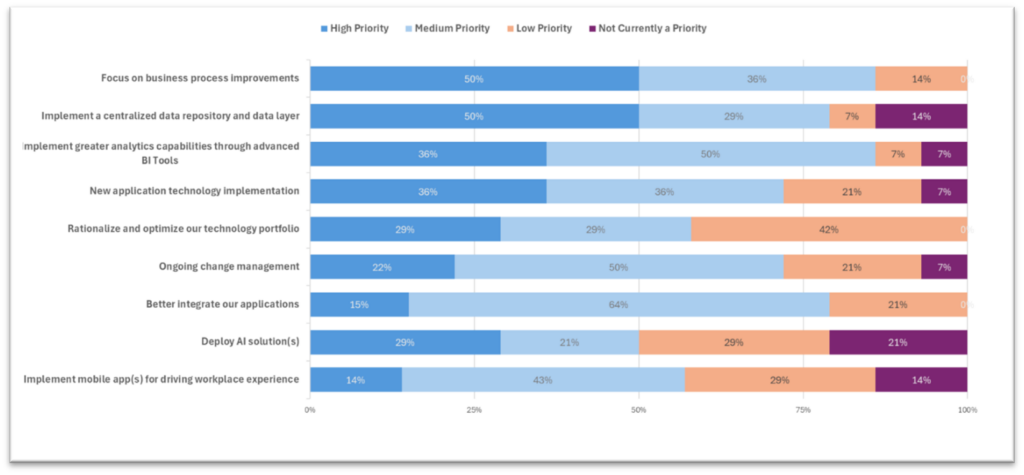
In the Trascent 2024 Corporate Real Estate (CRE) Technology Survey, participants were asked the following questions regarding their priorities for 2025:
Respondents were asked to rate their priorities on a scale of “Not a priority”, “Low Priority”, “Medium Priority” and “High Priority”. Based on these ratings, we arrived at an overall ranking of priorities – with the relative values (vs. absolute scores) being significant in our analysis. In this article, we will present a summary of the responses and their implications.
As context, we used the following reference model to frame the priorities:

As can be seen in the schematic, the core elements of any CRE team align with the familiar “four legs of the stool” that are intrinsic to the effective capabilities of the organization: People, Process, Tools and Data (aka capability pillars). In addition to the “four legs”, it’s equally important to highlight the four associated “enablers”:
The four “legs” or capability pillars are supported by these four enablers – roles, standardized work, domain architecture and data taxonomy standards. Indeed, without them, the capability pillars can lack effectiveness as we can attest having conducted multiple technology assessments for our clients.
Based on our survey, respondents ranked their 2025 priorities as follows:

Based on the above responses, we can calculate a weighted priority score that results in the corresponding bar chart:

Here, the priority score is calculated based on the number of respondents who ranked each initiative as “High”, “Medium”, “Low” or “Not a Priority”. Based on the above, we can summarize the responses as follows (in decreasing order of prioritization):
Priorities regarding Process/Standardized Work:
This is an important recognition that technology alone cannot drive an organization. The number one priority for respondents was improving business process.
Priorities regarding Data & Analytics/Data Taxonomy Standardization:
The second highest rated priorities reflect a trend we’ve seen for some time – a focus on data, analytics and the importance of data standardization that is a prerequisite for implementing a comprehensive data layer.
Priorities regarding Tools/Domain Architecture:
Priorities regarding CRE Technology:
Next in priority rankings were the three areas that relate to technology. Here, there is a marked contrast to earlier surveys regarding mobile apps for workplace experience (WX) which historically attracted much interest. Now, the highest priorities are Artificial Intelligence (although, not as high as the hype may indicate) and equally important is the significance of better application integration. Indeed, application interoperability within the CRE technology ecosystem is important for seamless enablement of business processes. Note that new technology implementation was the highest priority – indicating that respondents are looking for better solutions to replace the ones they have today or plug gaps in their organizational toolkit. Also, a significantly high rating was given to technology portfolio optimization. This underscores the importance of Domain Architecture and ensuring that the IT business partner organization continues to work with CRE for the most effective solutions and the retirement of ineffective or obsolete applications.
Priorities regarding People/Roles:
This focus area is important because it indicates that organizations recognize that to be effective, they must ensure that their most valuable assets – their people – are kept abreast of the unrelenting change that can swamp an organization. This is true both for CRE as well as at the enterprise level.
Based on responses to Trascent’s 2024 CRE Technology Survey, participants indicated that their top priorities were:
This shows that CRE organizations are taking a comprehensive approach to their 2025 initiatives with a balanced focus across process, data, technology and people. The responses also show a waning of interest in workplace experience technologies in favor of AI-based solutions.